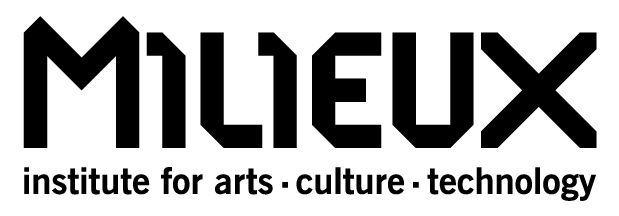On March 31, Milieux Institute celebrated its one year anniversary and we have been busy! In celebration, we’ve taken a look back at some of the research clusters’ most memorable talks, workshops, projects, symposiums, and exhibitions. ![]()
Skawennati, Becoming Sky Woman, 2017. Machinimagraph from She Falls For Ages. Photo: courtesy of the artist.
The Indigenous Futures research cluster has had an amazing year full of exciting activity.
Back in 2015, imagineNative Film and Media Festival invited us to partner with them, TIFF, and Pinnguaq to produce six Virtual Reality works that would respond to Canada’s 150th anniversary celebration by imagining the 150 years into the future from an Indigenous perspective. When 2016 rolled around, we hit the ground running and began work on two of those VR projects. In January, we hosted a week-long residency with artist collective Postcommodity, who got a crash course in VR from our amazing Research Assistants. They continued working remotely with our team throughout the year and returned in July to finalize the project they made. “Each Branch Determined” will debut at TIFF in June, as will “Blueberry Pie Under The Martian Sky” the second 2167 VR project, led by multimedia artist Scott Benesiinaabandan. His year-long residency, based here at Milieux, officially began on April 1 and was supported by a Canada Council New Media Residency grant.
Skawennati spent most of last year creating a new machinima, entitled “She Falls For Ages,” a sci-fi retelling of the Haudenosaunee creation story. It was presented at Oboro artist-run centre as part of her solo exhibition, Tomorrow People, in February of this year. She has already begun a new machinima, which will be a sci-fi retelling of the Haudenosaunee confederation story.
Throughout the year the cluster has continued with its two series: Illustrating the Future Imaginary, in which emerging artists are asked to create an illustration of the future; and the Future Imaginary Lecture Series, in which Indigenous academics are invited to share their thoughts on the future of their field. As well, we offered several Skins workshops in Digital Media: Along with student Sebastian Alvarez, Jason offered a six-week workshop (one per week) on Programming Fundamentals at Kahnawake Survival School. With the help of Erica Perrault and Darian Jacobs, Skawennati delivered several machinima workshops, including one at Eastern Bloc here in Montreal in February, an intro to Indigenous Character Design in Second Life in Yellowknife in the spring, and a 4-day intensive for the Native Youth Program, in Vancouver in August. (Watch the awesome machinimas the participants produced!)
Activiating AbTeC Island is an effort we began early last year, in which we invited folks to visit AbTeC Island, our headquarters in cyberspace (in Second Life) to see the environment, pick up skills (such as how to customize your avatar or build a snow man) or to simply hang out.
We have delivered multiple talks and Jason wrote a book chapter! Most of all this and more can be seen on our website, where we have an excellent blog as well as a very cool interactive timeline to check out.
At the end of the year, our cluster was thrilled to expand with the addition of Heather Igloliorte and her lab moving in down the hall from us. For the coming year, we are excited about the premier at TIIF in June, of the two 2167 VR pieces. In July we will deliver our Skins workshop in Aboriginal Storytelling and Videogame Design in Hawai’i and in November we’ll open an exhibition at the Leonard and Bina Ellen Gallery and attend the Initiative for Indigenous Future’s third symposium, being hosted by our partner in Winnipeg.
Text by Skawennati Fragnito 
Jolene Rickard speaking as part of the Future Imaginary Lectures series.

Kim TallBear speaking as part of the Future Imaginary Lectures series.



